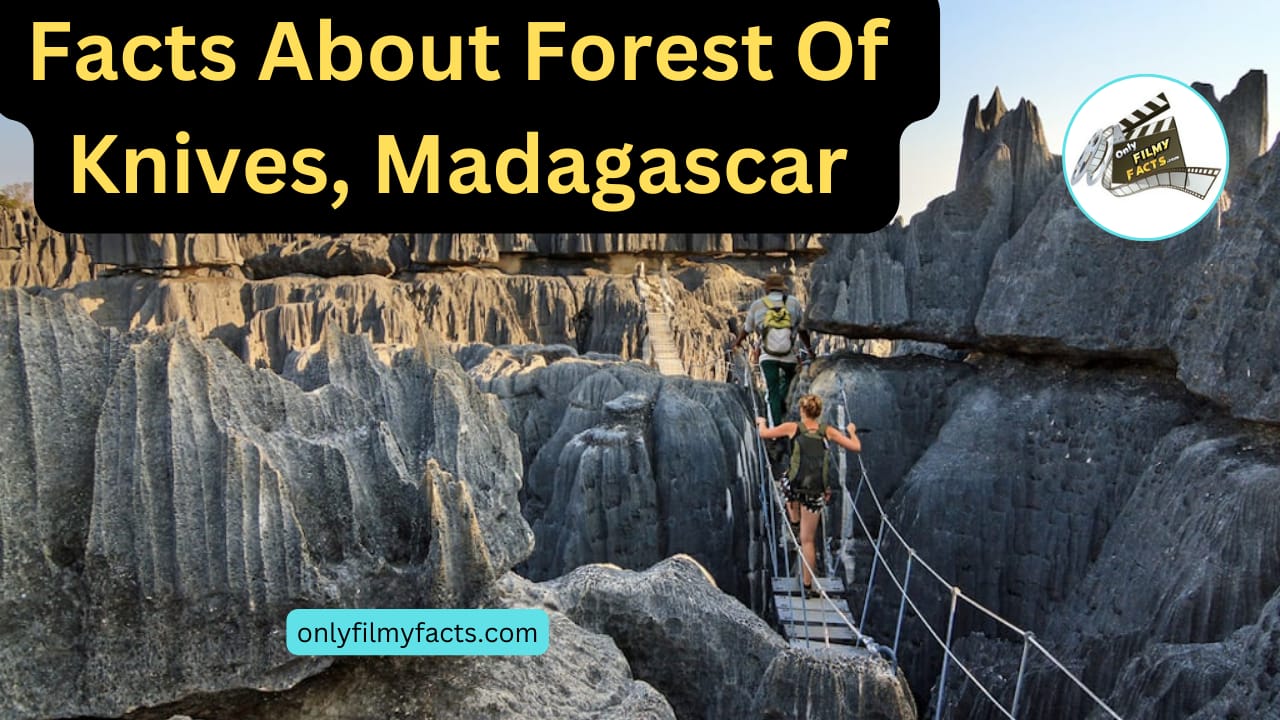Has there ever been a forest named after something that sounds like it belongs in a fantasy book? Explore Madagascar ‘s interior and learn the mystery of the Forest of Knives. The mysterious beauty and distinctive flora and fauna of Madagascar are well-known, but what is the Forest of Knives? The name of this prickly forest comes from the enormous limestone formations that rise out of the ground, resembling a set of knives right out of nature.
What if it was the topic of the family quiz night? Learning about a forest with such a dramatic name will astonish adults and children alike. Indeed, this forest is a testament to the wonders of Mother Nature and her ability to create art in the most unexpected ways; it’s not just about the catchy name.
Facts About The Forest Of Knives
This forest, which is hidden deep within Madagascar, is unlike any other forest. Instead of real knives, this place is filled with jagged stones that protrude like giant’s cutlery. The tall, naturally formed sculptures create an adventurer’s playground. Yes, Madagascar is more than just those cuddly lemurs! Put this place on your bucket list, but don’t forget to bring comfortable footwear. Nature’s artwork here is sharp!
- The Tsingy de Bemaraha National Park contains the Forest of Knives, which is situated on the island nation of Madagascar.
- The stone towers that rise out of the ground gave rise to the name Forest of Knives. The Little Tsingy and Great Tsingy limestone plateaus dominate the entire Tsingy de Bemaraha National Park. Travellers from all over the world come to this region of Madagascar to investigate the diverse ecosystems found on the island nation.
- These consist of lakes, mangroves, savannah, and dry deciduous forests. A vast range of animals, most of which are native to the island, can also be found in this area. According to scientists, the stone forest serves as an animal and bird species’ natural stronghold. The stone forests are difficult to explore and aren’t very friendly, despite the fact that many people want to see this fascinating region of the planet.
- In Western Madagascar, the forest spans an area of 197684.31 ac (80,000 ha).
How Was The Stone Forest In Madagascar Formed?
Geological formations in Madagascar’s Stone Forest, with their towering stone pinnacles rising majestically from the earth, are a testament to the artistry of nature. Those jagged peaks are as stunning as they are terrifying. Humid caves hidden beneath lend an additional air of mystery to this scene. The rich biological diversity that this region’s vegetation possesses is even more astounding. Many species have shown amazing adaptation inside this enclosure, surviving among these jagged rocks. Nature’s ability to combine resilience and unadulterated beauty is truly amazing.
- It took millions of years for Madagascar’s stone forest to form. According to studies, the accumulation of several calcite layers at the bottom to form a thick limestone bed is thought to have initiated the formation process of these rocks approximately 200 million years ago.
- The renowned limestone towers, some of which reach astonishing heights of hundreds of feet above the ground, were formed from this limestone bed. It is thought that after the limestone bed formed, it rose to form a plateau, which groundwater gradually eroded over time to form a network of ravines, gorges, and caverns.
- It is thought that erosion happened in both vertical and horizontal directions. Visitors who work in the scientific community explain that the limestone’s needle-like shape is the product of erosion. It appears to be a pine forest as a result.
What Is Special About Tsingy De Bemaraha?
Nestled in western Madagascar, Tsingy de Bemaraha is a breathtaking example of the artistry of nature. This extraordinary area is home to a flourishing centre of biological diversity in addition to being a breathtaking display of pointed stone formations. This jumbled limestone maze has merited recognition as a UNESCO World Heritage site. It’s home to some of the most unusual plants and animals on Earth, which adds to its allure despite its rocky appearance.
- This natural wonder’s meandering Manambolo River enhances the area’s insular qualities by providing access points for some species. Numerous new species that are not found anywhere else on the planet have emerged as a result of this isolation.
- It makes sense that Tsingy de Bemaraha’s complex combination of difficult terrains and its abundant life is so alluring to explorers and scientists alike. The area’s extraordinary significance and the mysteries that lie within its depths are highlighted by the sheer diversity and the discovery of new species amidst these formations.
- Despite the fact that limestone covers most of the land in this area, the trees here have adapted to their surroundings and aren’t exactly like the trees you see elsewhere.
Tsingy De Bemaraha National Park
Tsingy de Bemaraha National Park is a sanctuary of spectacular natural landscapes located in Madagascar. This park, which is home to a wide variety of plant and animal species, exhibits a well-balanced fusion of floral and faunal species, all of which contribute to its distinct biodiversity. Tsingy de Bemaraha was once a strict nature reserve, but in order to further ensure the preservation of its priceless ecosystems, it has subsequently extended its protective boundaries to include an adjacent nature reserve. A trip here is guaranteed to provide breathtaking views, an amazing natural setting, and a close-up encounter with the wonders of nature.
- The island nation of Madagascar’s northwest is home to the Tsingy de Bemaraha National Park. Situated in the Antsalova District, it has been acknowledged as a UNESCO World Heritage Site.
- The Tsingy de Bemaraha National Park has rivers and streams as well, which sheds light on the area’s biodiversity.
- The park’s extensive network of underground caverns, which is a maze of passageways and rooms just waiting to be discovered, is one of its most notable features.
- It covers 151999 hectares (375,600 acres) in Western Madagascar.
- The 11 lemur species found in the Tsingy de Bemaraha National Park are unique to this region of the world, even though the majority of the park is still unexplored.
- The Tsingy de Bemaraha National Park is among the greatest locations to visit, despite obstacles. A few aerial bridges have been built in the past to let visitors ascend between the limestone peaks and take in the bizarre vistas.
- Today, visitors can explore a large portion of the national park with a certified guide while taking all the safety precautions associated with climbing. One of the main draws of this national park is its hidden wildlife, which is in addition to its unparalleled hiking experiences.
- The Ring-tailed mongoose, the endangered Antsingy leaf chameleon, the cat-like fossa, the western and eastern Falanouc, and numerous other animal species can be found in the Tsingy de Bemaraha National Park.
Madagascar’s Forest of Knives is more than just a location with an enigmatic name—it’s a symbol of the resilient spirit of the natural world. Its dramatic name may conjure up images of fantasy, but its real-life presence is just as captivating. The stark, angular limestone formations may look frightening at first, but beneath their sharp edges lies a vibrant world.
Venturing there? Remember, those limestone formations can be as sharp as their names suggest, so packing some sturdy shoes is a must! Beyond the warning stories, though, this forest offers a once-in-a-lifetime experience. So why not let this be your next bucket-list destination? Bring your sense of adventure, follow your curiosity, and immerse yourself in the fantastical stories that nature has to tell.
Content’s
Sources
https://www.inaturalist.org/places/tsingy-de-bemaraha
https://whc.unesco.org/en/list/494/
https://en.wikipedia.org/wiki/Tsingy_de_Bemaraha_National_Park

